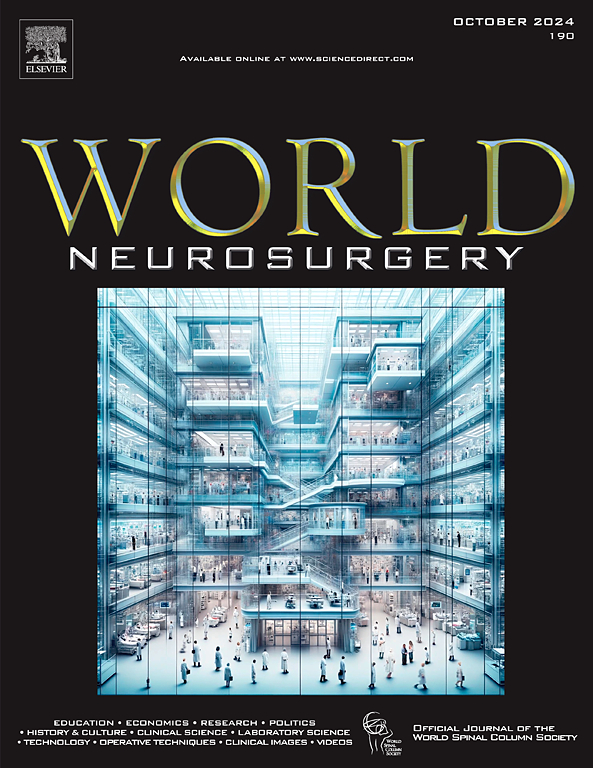Sole Stenting versus Stent-Assisted Coiling for Treating Dissecting Posterior Circulation Aneurysms: A Systematic Review and Meta-Analysis
IF 1.9
4区 医学
Q3 CLINICAL NEUROLOGY
引用次数: 0
Abstract
Background
Among the reconstructive methods for treating dissecting posterior circulation aneurysms, there are stent-assisted coiling (SAC), and sole stenting (SS) therapy. Despite SAC being widely employed when compared to SS, no study systematically analyzed the difference in their outcomes.
Methods
The authors conducted a meta-analysis of studies employing both therapies to compare their outcomes. A search was performed in January 2024, including only studies with consecutive patients submitted to SS or SAC. The studies had to have at least one of the following outcomes: complete aneurysm occlusion, complications, mortality, aneurysm recurrence, retreatment, and good clinical outcome. Odds ratio (OR) with 95% confidence interval (CI) were utilized for statistics.
Results
In a pooled analysis of 17 studies, comparing 173 SS and 377 SAC procedures for dissecting posterior circulation aneurysms, no significant differences were found in related mortality (OR 1.44; 95% CI 0.49–4.27); total mortality (OR 1.33; 95% CI 0.53–3.37); retreatment (OR 0.45; 95% CI 0.16–1.26); recurrence (OR 1.00; 95% CI 0.43–2.33); postoperative complete aneurysmal occlusion (OR 0.79; 95% CI 0.09–6.77); follow-up complete aneurysmal occlusion (OR 1.57; 95% CI 0.62–3.94); intraoperative complications (OR 1.04; 95% CI 0.29–3.73); postoperative complications (OR 1.22; 95% CI 0.61–2.45); hemorrhagic complications (OR 2.16; 95% CI 0.77–6.06); ischemic complications (OR 1.68; 95% CI 0.68–4.15). Good clinical outcomes significantly favored SAC (OR 0.45; 95% CI 0.23–0.86).
Conclusions
The findings suggest there is no substantial basis for favoring SAC over SS across all cases. Instead, an individualized approach should be considered, according to the patient's characteristics, surgeon skills, and the available material.
单纯支架植入与支架辅助卷曲治疗剥脱性后循环动脉瘤:系统回顾与元分析》。
背景在治疗剥脱性后循环动脉瘤(DPCAs)的重建方法中,有支架辅助卷曲(SAC)和单纯支架治疗(SS)。作者对采用这两种疗法的研究进行了荟萃分析,以比较它们的疗效。研究人员于 2024 年 1 月进行了一项检索,其中只包括对连续接受 SS 或 SAC 治疗的患者进行的研究。这些研究必须至少有以下一项结果:动脉瘤完全闭塞、并发症、死亡率、动脉瘤复发、再治疗和良好的临床结果。结果在对 17 项研究进行的汇总分析中,比较了 173 例 SS 和 377 例 SAC DPCA 手术,发现在相关死亡率(OR 1.44;95% CI 0.49-4.27)、总死亡率(OR 1.33;95% CI 0.53-3.37)、再治疗(OR 0.45;95% CI 0.16-1.26)、复发(OR 1.00;95% CI 0.43-2.33);术后完全动脉瘤闭塞(OR 0.79;95% CI 0.09-6.77);随访完全动脉瘤闭塞(OR 1.57;95% CI 0.62-3.94);术中并发症(OR 1.04;95% CI 0.29-3.73);术后并发症(OR 1.22;95% CI 0.61-2.45);出血性并发症(OR 2.16;95% CI 0.77-6.06);缺血性并发症(OR 1.68;95% CI 0.68-4.15)。良好的临床结果明显倾向于 SAC(OR 0.45;95% CI 0.23-0.86)。结论:研究结果表明,在所有病例中,SAC 比 SS 更受青睐并无实质性依据,相反,应根据患者的特征、外科医生的技能和可用材料考虑个体化方法。
本文章由计算机程序翻译,如有差异,请以英文原文为准。
求助全文
约1分钟内获得全文
求助全文
来源期刊

World neurosurgery
CLINICAL NEUROLOGY-SURGERY
CiteScore
3.90
自引率
15.00%
发文量
1765
审稿时长
47 days
期刊介绍:
World Neurosurgery has an open access mirror journal World Neurosurgery: X, sharing the same aims and scope, editorial team, submission system and rigorous peer review.
The journal''s mission is to:
-To provide a first-class international forum and a 2-way conduit for dialogue that is relevant to neurosurgeons and providers who care for neurosurgery patients. The categories of the exchanged information include clinical and basic science, as well as global information that provide social, political, educational, economic, cultural or societal insights and knowledge that are of significance and relevance to worldwide neurosurgery patient care.
-To act as a primary intellectual catalyst for the stimulation of creativity, the creation of new knowledge, and the enhancement of quality neurosurgical care worldwide.
-To provide a forum for communication that enriches the lives of all neurosurgeons and their colleagues; and, in so doing, enriches the lives of their patients.
Topics to be addressed in World Neurosurgery include: EDUCATION, ECONOMICS, RESEARCH, POLITICS, HISTORY, CULTURE, CLINICAL SCIENCE, LABORATORY SCIENCE, TECHNOLOGY, OPERATIVE TECHNIQUES, CLINICAL IMAGES, VIDEOS
 求助内容:
求助内容: 应助结果提醒方式:
应助结果提醒方式:


